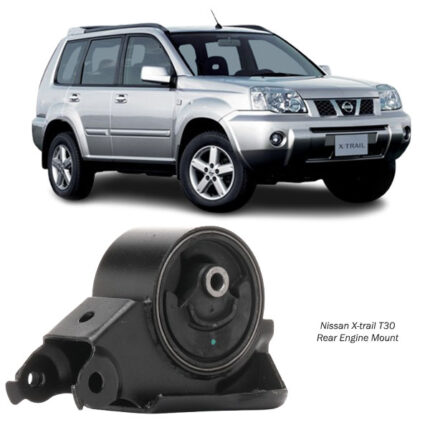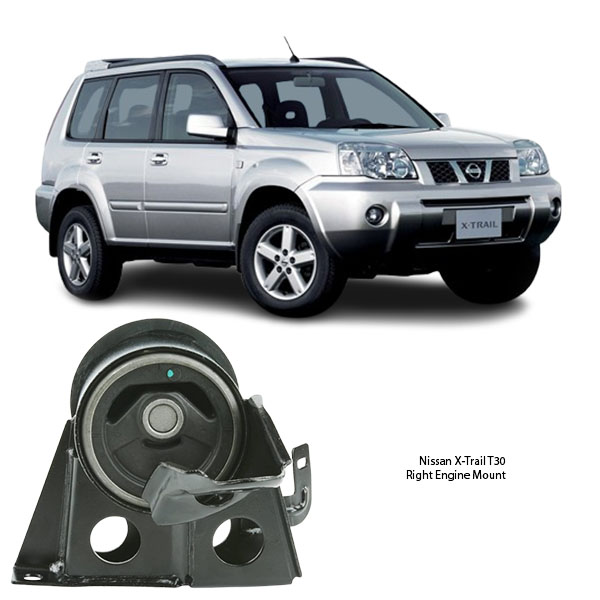-9%
Get Nissan X-trail T30 Right Engine Mount 11210-8H305 in Kenya.
The Right Engine Mount is a critical component in a vehicle’s engine mounting system, playing a crucial role in stabilizing the engine, absorbing vibrations, and minimizing noise transmission. It is specifically designed to hold the engine securely on the right side of the vehicle, which is typically the passenger side in left-hand drive vehicles and the driver’s side in right-hand drive vehicles.
Engine mounts are essential in maintaining engine stability, ensuring a smooth ride, and preventing excessive engine movement that could lead to damage in surrounding components. Since engines generate substantial torque and vibrations during operation, a properly functioning mount is vital for vehicle performance and longevity.
2. Functions of a Right Engine Mount
A well-designed right engine mount performs the following functions:
2.1. Engine Stability
The primary function of the engine mount is to keep the engine securely attached to the vehicle’s chassis. Since the engine produces rotational force (torque), it needs to be firmly held in place to prevent unwanted movement that could affect vehicle handling.
2.2. Vibration Dampening
Engines create significant vibrations when running, and without proper mounts, these vibrations would transfer directly to the vehicle’s frame. The right engine mount, typically made of rubber or hydraulic material, absorbs these vibrations, resulting in a smoother ride.
2.3. Noise Reduction
A failing or worn-out mount can cause excessive noise as the engine moves freely, making clunking, knocking, or rattling sounds. A properly functioning mount minimizes noise and keeps the cabin quieter.
2.4. Shock Absorption
Vehicles experience shocks from potholes, bumps, and sudden braking. The right engine mount helps absorb these forces, protecting the engine and preventing potential damage.
2.5. Weight Distribution
Engine mounts are strategically placed to balance the engine’s weight. The right engine mount, in combination with the left and rear mounts, ensures proper weight distribution, preventing stress on one side of the engine.
3. Types of Engine Mounts
Engine mounts come in different designs, and the right engine mount can be one of the following types:
3.1. Rubber Engine Mounts
- The most common type.
- Made of solid rubber, which absorbs engine vibrations.
- Durable but prone to wear over time due to exposure to heat and engine fluids.
3.2. Hydraulic Engine Mounts
- Filled with a fluid-based system to dampen vibrations.
- More effective in reducing vibrations compared to rubber mounts.
- Can develop leaks, leading to failure.
3.3. Electronic (Active) Engine Mounts
- Uses sensors and actuators to adjust dampening levels.
- Common in high-end and luxury vehicles.
- More expensive but offers superior vibration control.
3.4. Polyurethane Engine Mounts
- Designed for performance vehicles requiring extra rigidity.
- Provides better engine stability but increases vibrations.
- Less prone to wear than rubber mounts.
4. Symptoms of a Failing Right Engine Mount
A failing engine mount leads to noticeable problems in vehicle operation. Here are some common symptoms:
4.1. Excessive Vibrations
When the rubber or hydraulic fluid inside the mount wears out, it loses its ability to dampen vibrations, leading to excessive shaking inside the cabin.
4.2. Clunking or Knocking Noises
A damaged mount may allow the engine to move excessively, causing metal-to-metal contact, resulting in knocking or thumping noises, especially during acceleration and braking.
4.3. Engine Movement or Tilting
If the right engine mount is broken, the engine may shift or tilt noticeably when pressing the accelerator or turning. This excessive movement can damage other components.
4.4. Misalignment of Components
When an engine mount fails, hoses, belts, and wiring connected to the engine may stretch, causing premature wear and potential failure.
4.5. Rough Idling
If a mount is failing, the engine may shake abnormally at idle, causing discomfort inside the vehicle.
4.6. Fluid Leaks (For Hydraulic Mounts)
Hydraulic mounts contain liquid-filled chambers to reduce vibrations. If these chambers develop leaks, the mount will lose its effectiveness and need replacement.
5. Causes of Engine Mount Failure
Several factors contribute to premature wear or failure of an engine mount:
5.1. Age and Wear
Rubber components degrade over time due to exposure to heat and engine vibrations, eventually leading to cracks and loss of elasticity.
5.2. Engine Fluid Leaks
Oil, coolant, and transmission fluid leaks can deteriorate rubber mounts, causing them to become soft and ineffective.
5.3. Driving Conditions
- Frequent hard acceleration or braking increases stress on engine mounts.
- Rough terrain and potholes can accelerate wear and tear.
5.4. Poor Installation
Incorrectly installed mounts may not distribute the engine’s weight properly, leading to premature failure.
5.5. Manufacturing Defects
Low-quality or counterfeit mounts may not last long, leading to early breakdowns.
6. Maintenance Tips for Engine Mount Longevity
To ensure your right engine mount lasts longer, follow these maintenance tips:
✔ Regular Inspections – Check mounts for cracks, wear, and fluid leaks during routine vehicle servicing.
✔ Avoid Sudden Acceleration and Braking – Reduces stress on mounts.
✔ Fix Oil and Coolant Leaks Promptly – Prevents rubber degradation.
✔ Use Quality Replacement Parts – OEM or high-quality aftermarket mounts offer better longevity.
✔ Replace in Pairs if Necessary – If one mount fails, others may be weakened and need replacement.
7. Right Engine Mount Replacement Process
If a right engine mount fails, replacing it is necessary to prevent engine damage. The general steps include:
7.1. Tools Needed:
- Hydraulic jack
- Engine support bar
- Socket wrench set
- Torque wrench
- Pry bar
7.2. Replacement Steps:
- Secure the Vehicle – Park on a flat surface and engage the parking brake.
- Support the Engine – Use a jack or engine hoist to support the engine’s weight.
- Locate the Right Engine Mount – Typically found on the right side near the engine bay.
- Remove Mounting Bolts – Loosen and remove the bolts securing the old mount.
- Install New Mount – Position the replacement mount and secure it with bolts.
- Torque to Manufacturer Specifications – Ensures proper fitment.
- Lower the Engine and Test – Start the engine and check for excessive vibrations or noise.
A professional mechanic should handle this process if you are unsure about performing the replacement yourself.
8. Conclusion
The Right Engine Mount is essential for securing the engine, minimizing vibrations, and maintaining a smooth driving experience. A failing mount can cause excessive noise, shaking, and even engine misalignment. Regular inspections, proper maintenance, and timely replacement ensure optimal vehicle performance and safety.
Follow us on Facebook for more parts.



